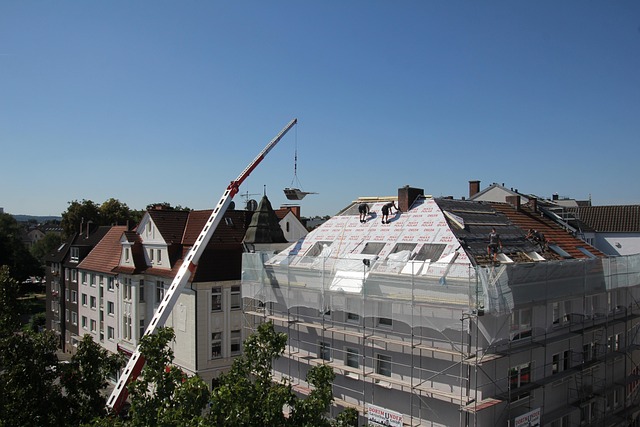Low slope roofing is a cost-effective and durable choice for commercial structures like warehouses, featuring gentle slopes, efficient drainage systems, and advanced materials. Its simplicity streamlines installation and maintenance while safeguarding against water damage. Common materials include bitumen, PVC, and TPO, offering flexibility and long lifespans. Installation requires meticulous preparation, including substrate cleaning, underlayment, and water-resistant membranes, with best practices emphasizing flashing, drainage, inspections, and aesthetic slopes. Regular maintenance involves leak detection, re-coating, and sealing to extend the roof's lifespan. While environmental concerns exist, sustainable low slope roofing solutions like recycled materials and green roofs mitigate these issues while promoting energy efficiency and building durability.
Low slope roofing is a popular choice for warehouses and large commercial buildings, offering numerous advantages over traditional steep-pitched systems. This comprehensive guide explores the intricacies of shallow-pitched roofs, from their benefits, like cost-effectiveness and quick installation, to the materials used and best practices for maintenance. We’ll also delve into environmental considerations, showcasing how low slope roofing contributes to sustainable building design.
- Understanding Low Slope Roofing: An Overview
- Advantages of Shallow-Pitch Roof Systems in Warehouses
- Common Materials Used for Low Slope Roofs
- Installation Process and Best Practices
- Maintenance and Longevity: Ensuring Optimal Performance
- Environmental Impact and Sustainable Roofing Solutions
Understanding Low Slope Roofing: An Overview

Low slope roofing is a prevalent choice for commercial structures, especially warehouses and large-scale industrial buildings. This style of roofing refers to roofs with a gentle, gradual slope rather than the steeper angles typically seen in residential or sloped roof design applications. The low pitch of these roofs makes them easily recognizable, offering several advantages tailored to commercial spaces.
These systems are designed for efficiency and cost-effectiveness while prioritizing long-term durability. Low slope roofing incorporates advanced materials and techniques for effective water management, a critical aspect in regions with varying climates. By integrating specialized roof drainage systems, these low pitch roofs ensure proper water flow, preventing potential damage caused by pooling or evaporation issues. This overview highlights the simplicity and functionality of low slope roofing, making it a popular choice for modern commercial architecture.
Advantages of Shallow-Pitch Roof Systems in Warehouses

Shallow-pitched roofing systems, often referred to as low slope roofing, offer several advantages for warehouses and large commercial spaces. One of the primary benefits is their simplicity and cost-effectiveness. Unlike sloped roof designs, which require intricate structural support for steep angles, low pitch roofs are easier and cheaper to install and maintain. This makes them an attractive option for businesses looking to minimize upfront costs without compromising on durability.
Moreover, these roofing systems integrate seamlessly with efficient roof drainage systems, ensuring that water is swiftly and effectively removed from the surface. This feature is particularly crucial in warehouse environments where large expanses of flat roofing can accumulate significant amounts of rainwater. Efficient drainage not only prevents water damage to the building’s structure and contents but also reduces the risk of leaks and other maintenance issues, contributing to a longer-lasting and more reliable roof.
Common Materials Used for Low Slope Roofs

Low slope roofing systems, often found in warehouses and large commercial spaces, utilize a variety of materials known for their durability and water-resistant properties. Commonly used materials include bitumen, a type of asphalt, which is coated over a fabric membrane to create a protective barrier against weather elements. This combination offers excellent resistance against leaks and provides an efficient and cost-effective solution for large, flat surfaces.
Another popular choice is PVC (polyvinyl chloride) and TPO (thermoplastic olefin) membranes. These synthetic materials are known for their flexibility, puncture resistance, and long lifespan. They can be installed over a range of substrates, including metal, concrete, or existing shingles, making them versatile for various low pitch roof designs. Additionally, these materials often incorporate integrated roof drainage systems to ensure proper water flow and prevent damage from water accumulation.
Installation Process and Best Practices

The installation process for low slope roofing systems, prevalent in warehouses and large commercial spaces, involves careful planning and precise techniques. It starts with preparing the substrate, ensuring it’s clean, dry, and free from any debris. A crucial step is applying an appropriate underlayment, which provides a protective barrier between the roof deck and the final roofing material. This is followed by the placement of the low-slope roofing membrane, often in long rolls, which offers superior water resistance.
Best practices for installing these systems emphasize proper flashing around penetrations like vents and pipes to maintain integrity. Efficient roof drainage systems are essential for managing water flow, preventing ponding, and reducing the risk of damage. Additionally, regular inspections during installation ensure compliance with safety standards and code requirements. Incorporating sloped roof design elements, such as gentle slopes instead of sharp angles, aids in water runoff while maintaining aesthetic appeal.
Maintenance and Longevity: Ensuring Optimal Performance

Low slope roofing systems, commonly found in warehouses and large commercial spaces, require a different approach to maintenance compared to their steep-pitched counterparts. Regular inspections are crucial for ensuring optimal performance and longevity. This includes checking for signs of leaks, damaged or missing shingles, and proper roof drainage systems. Early detection of issues can prevent minor problems from escalating into costly repairs.
Proper maintenance involves not only fixing visible damage but also addressing the overall health of the roofing material. For low pitch roofs, this may include re-coating or sealing to protect against moisture intrusion, which is a common cause of deterioration in these systems. By implementing a proactive maintenance schedule and using suitable materials designed for low slope applications, building owners can maximize the lifespan of their commercial roofing system, ensuring continued protection for the interior space below.
Environmental Impact and Sustainable Roofing Solutions

The environmental impact of low slope roofing systems is a growing concern, as these structures are often found in large commercial buildings and warehouses, contributing to urban heat islands. Unlike traditional sloped roof designs, which promote water runoff and potential flooding, low pitch roofs require effective roof drainage systems to manage rainwater efficiently. This not only reduces the risk of structural damage but also minimizes the ecological footprint by preventing water pollution.
Sustainable roofing solutions are emerging as a response to these challenges. Eco-friendly materials like recycled rubber, cool roofs that reflect sunlight, and green roofs with vegetation offer viable alternatives. These innovations not only reduce energy consumption and greenhouse gas emissions but also enhance the overall durability of buildings. By embracing these environmentally conscious low slope roofing options, commercial spaces can contribute to a greener future while ensuring optimal structural integrity.
